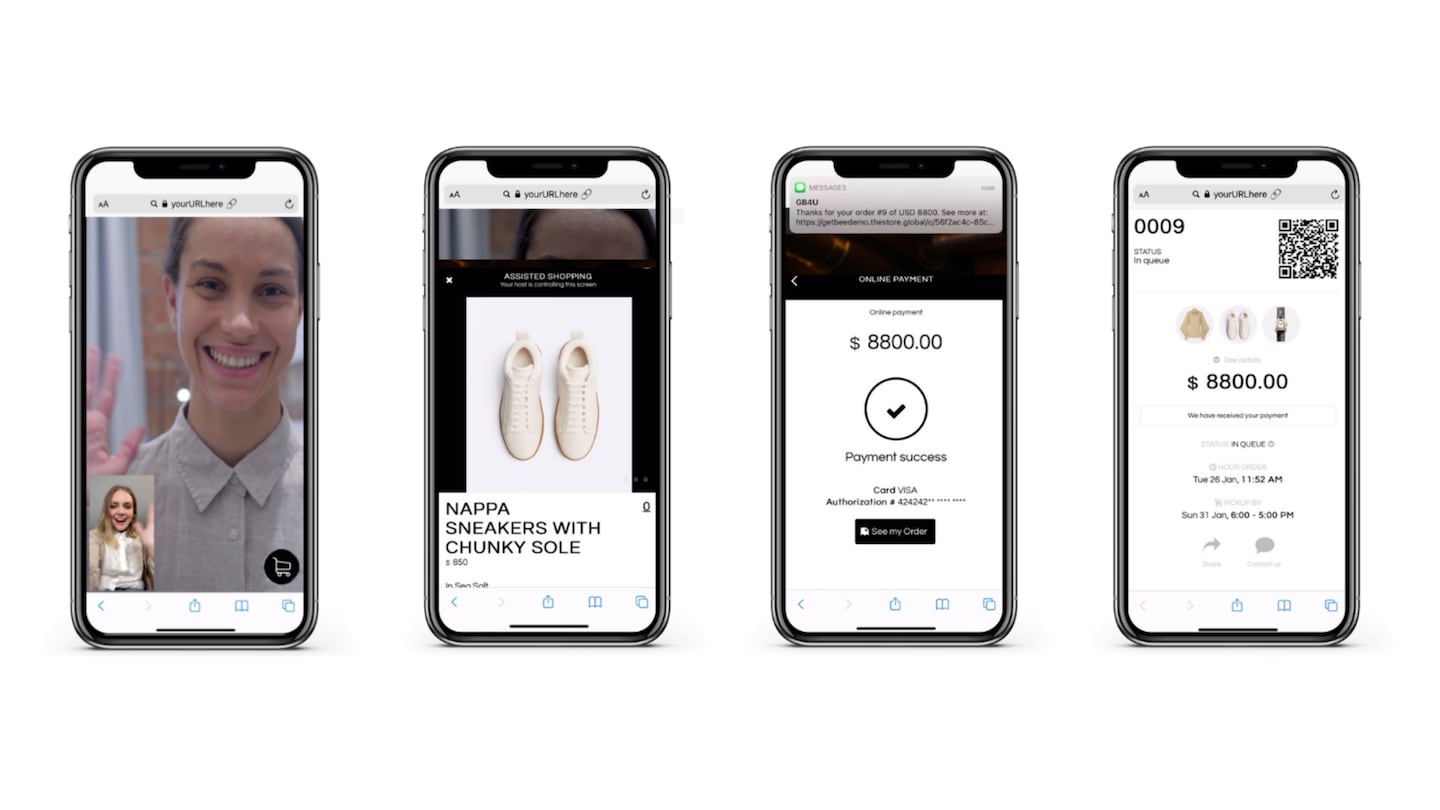
The Business of Fashion
Agenda-setting intelligence, analysis and advice for the global fashion community.

Agenda-setting intelligence, analysis and advice for the global fashion community.

The Covid-19 pandemic has dramatically shifted consumer behaviour and the momentum in e-commerce is only set to accelerate. According to McKinsey & Co. analysis, over a period of just eight months in 2020, e-commerce’s share of fashion sales nearly doubled from 16 percent to 29 percent globally, jumping forward six years’ worth of growth. Indeed, fashion executives see digital as the biggest opportunity by far in 2021, with 70 percent of executives expecting growth of more than 20 percent in their e-commerce channels, according to BoF’s State of Fashion 2021 report.
A software that empowers brands to offer personalised services online that looks and feels like theirs, Getbee offers a fully integrated solution that comes with virtual appointments, live video consultations, assisted shopping, payments and more to brands such as the Chalhoub Group, Lancôme and Dolce & Gabbana.
By creating software that integrates selling and clienteling tools, Getbee has sought to bridge the gap between its partners and their customers since its inception in 2018. With e-commerce firmly front of mind for the fashion industry, Getbee views bringing the same in-store levels of service and care into the digital space as a valuable means of innovating the customer experience, hoping to empower brands with the digital clienteling necessary for more emotional, higher priced purchases.

Now, BoF sits down with founder and CEO Thea Myhrvold to discuss Getbee’s commitment to “humanised technology,” how to best fuse online and offline clienteling strategies and community-building via retail workforces.
What insights can Getbee share around e-commerce consumer behaviour?
Covid-19 has certainly accelerated underlying trends — the shift to online and subsequent changes in consumer behaviour. However, no matter how advanced technology gets, that human connection within retail is something that cannot be replaced. When we consider luxury retail, we used to say emotional purchases because if you think about luxury — fashion, bridal, baby or even home — these are all emotional [categories]. Customers need to trust that this is the right purchase for their needs, which is something a chatbot cannot offer.
Technology can be used to facilitate those connections in a more meaningful way and help retain the fundamentals of good business. In 2020, we rolled out and deployed branded solutions across 18 brands in less than three weeks, as consumers have new expectations of how [service] will work in an online world.
Across our platforms, the average time spent in a one-on-one session in 2020 was around 40 minutes, with some customers spending up to 3 hours in personalised makeup tutorials, which [translated] to high cart shopping values. A personalised service ultimately leads to a higher retention of clients because the experience becomes more purposeful and drives more confidence in the products they buy.
Why should retailers consider merging physical and virtual experiences?
When it comes to virtual reality strategies, so many retailers are invested in the specific brick-and-mortar experience — and attempting to recreate that [experience] online. However, if you consider it from a shopper psychology perspective, in a physical store, the shopper is touching, smelling and feeling. It’s a very physical experience, right down to the carpets, doors and lighting. That’s difficult to translate into an online reality.
It’s about bringing a personal touch back to a digital world.
Today, virtual stores and shopping online can be a lonely experience. Customers can explore a virtual store, but there is little interaction. If a shopper wants to purchase a $10,000 watch, they want to make sure that it’s the right item and that the sizing and colours are correct. The customer needs to be confident in their ability to purchase the right item for them.
A lot of retailers invest money in training store associates, so how can you leverage these people in a physical and virtual way and create this kind of hybrid work environment? Bringing that level of customer experience into a virtual world is where we’re seeing the biggest potential in [fusing] the physical and the virtual. Human touchpoints are the piece that is missing in that lonely e-commerce experience — simply talking to someone.
How has the role of the store associate changed since the pandemic?
The [pandemic] has required brands to leverage existing store associates to build a virtual workforce. It’s something all industries are experiencing, so it’s a universal transition from a very physical experience to a virtual one.
To date, a lot of the tools that store associates have had are fragmented. From WhatsApp to SMS and Instagram, they have had to use several different kinds of tools to connect to clients. We’ve been told stories of $10,000 watches sold via WhatsApp, with store associates actually asking for a photo of the customer’s credit card via WhatsApp. That is not going to scale, that’s not safe, that’s not GDPR compliant, and it is definitely not on-brand from a luxury perspective.
Brands need to leverage this global workforce in a simple and safe way, actually sell online, represent your brand. In some sense, the sales associates have become thousands and thousands of virtual stores themselves. It’s taking that element to the next step and making sure that employees are empowered with the correct training and streamlined tools in order to sell this way.
What operational advantages can retailers expect in investing in the right clienteling platform?
Our whole ethos is, “How can we leverage technology to facilitate and empower more meaningful connections?” Today, plenty of tech companies are trying to replace people via machine learning and chatbots, but we believe that this industry is centred on people — and technology is a way to scale that experience. Businesses should be [considering] how to use technology to empower them.
Chatbots cannot replicate personalised customer service online. 86 percent of online shoppers prefer to interact with a human, rather than a chatbot.
From a conversion rate perspective, the global average on e-commerce sales is around 2 to 3 percent. As an overall average, our clients see a 25 percent conversion rate through their Getbee-powered platform. Importantly, we have not just seen an increase in sales, but it’s also increasing in retuning customers, thanks to service and satisfaction. Our clients see a 98 percent customer satisfaction rate, increasing loyalty, retention and an upsell of lifetime value.
Operationally, there are further benefits. Businesses are able to attract and retain top talent, as they are empowering their team to work in a remote, hybrid way, incentivising them to sell online with easy commissions for sales, as everything can be traced and tracked in a simple way.
What new technologies do you expect will provide further opportunity within digital clienteling?
The in-video checkout experience is something that feels significant. Currently, there are plenty of other marketplaces where livestreaming doesn’t sit under the brand, but rather hosts livestream shopping for large groups. Elsewhere, we are not seeing that personalised one-on-one experience yet. I definitely believe that is a unique piece that we are empowering brands with and that we will begin to double down on.
When we talk to a lot of our clients, they often say that most [shoppers] are, for lack of a better term, lazy, especially online. We want things to be quick and carried to us. The average cart abandonment rate across e-commerce is almost 70 percent.
Having someone online doing it for you in real-time, personalising and curating your shopping cart, will be significant — particularly if it is an emotional purchase. It’s about [technology] that makes the customer feel comfortable and confident in their purchase and reduces the number of steps they have to make in that journey.
What are the growth levers for clienteling strategies over the medium term?
Retailers need to consider how they re-own their customers and their data. If brands continue to use different, fragmented clienteling tools, the brand is unable to own and optimise that customer data. Having a singular channel that is branded will be increasingly important.
Of course, customers are excited to return to stores, but fundamental mindset shifts have occurred. The customer is now cemented in terms of their behaviour and purchase patterns and specifically how they actually expect things to work in an online world, with Covid-19 an accelerative force of underlying trends.
We anticipate that physical retail will be more of a showroom, while a lot of the purchasing decisions will actually be made online. We are all used to booking an Uber on-demand or ordering food, but why not talk to a stylist online, a skincare specialist or makeup artist? It feels like the next, natural extension. These are services that, as consumers, we are all now used to, but brands haven’t taken that step to offering it yet. It’s the next level of customer experience.
This is a sponsored feature paid for by Getbee as part of a BoF partnership.
From analysis of the global fashion and beauty industries to career and personal advice, BoF’s founder and CEO, Imran Amed, will be answering your questions on Sunday, February 18, 2024 during London Fashion Week.
The State of Fashion 2024 breaks down the 10 themes that will define the industry in the year ahead.
Imran Amed reviews the most important fashion stories of the year and shares his predictions on what this means for the industry in 2024.
After three days of inspiring talks, guests closed out BoF’s gathering for big thinkers with a black tie gala followed by an intimate performance from Rita Ora — guest starring Billy Porter.